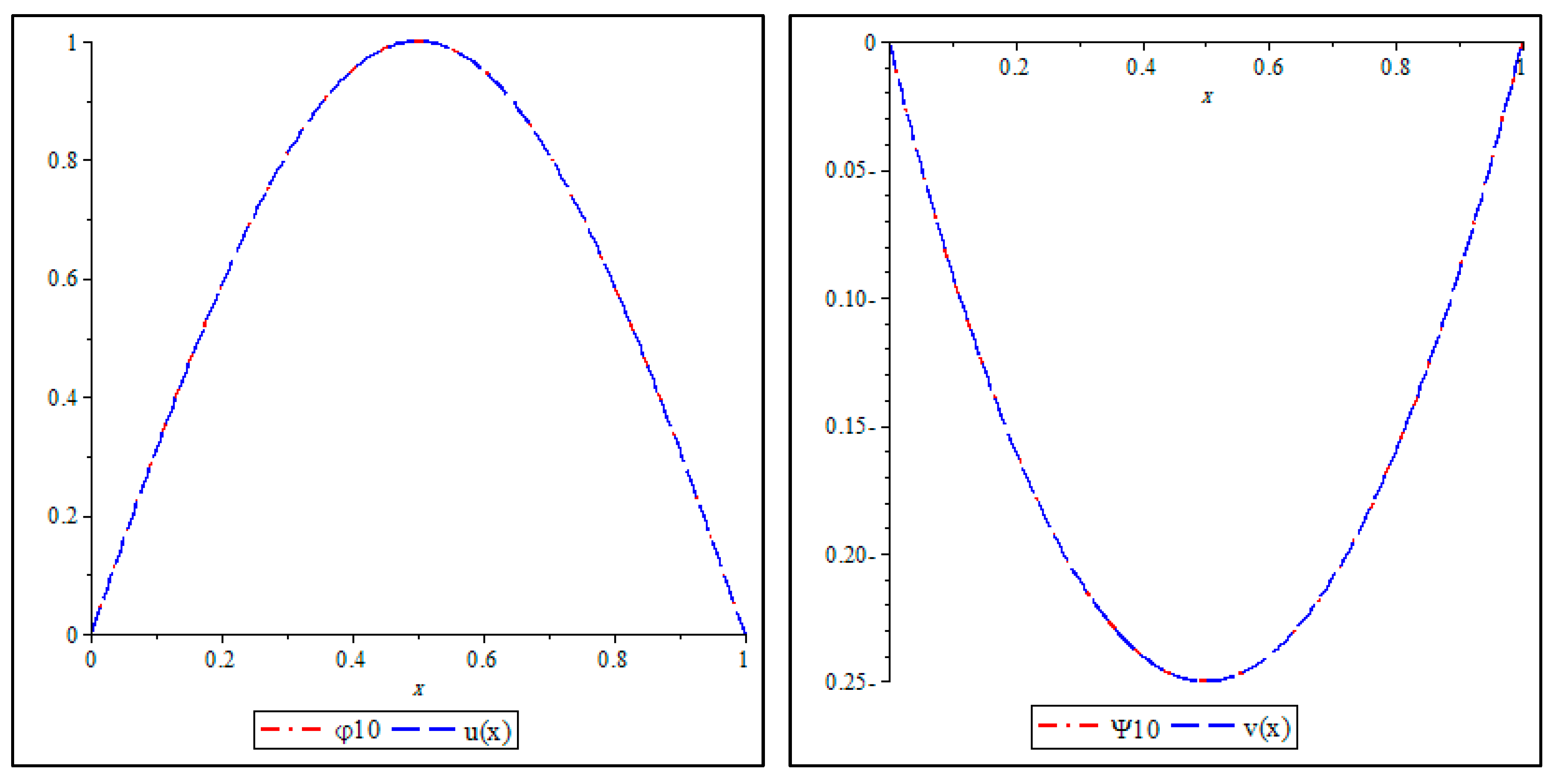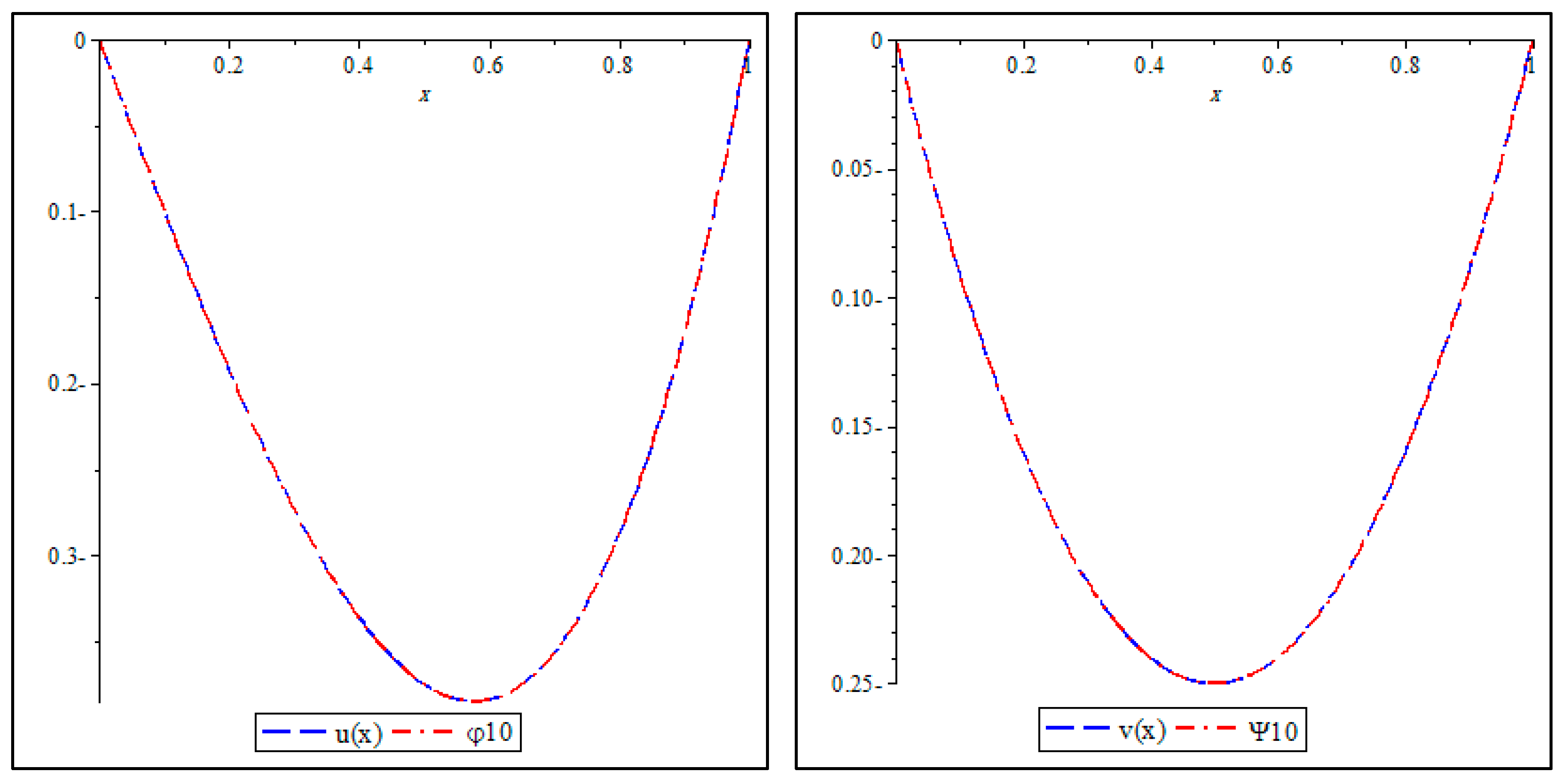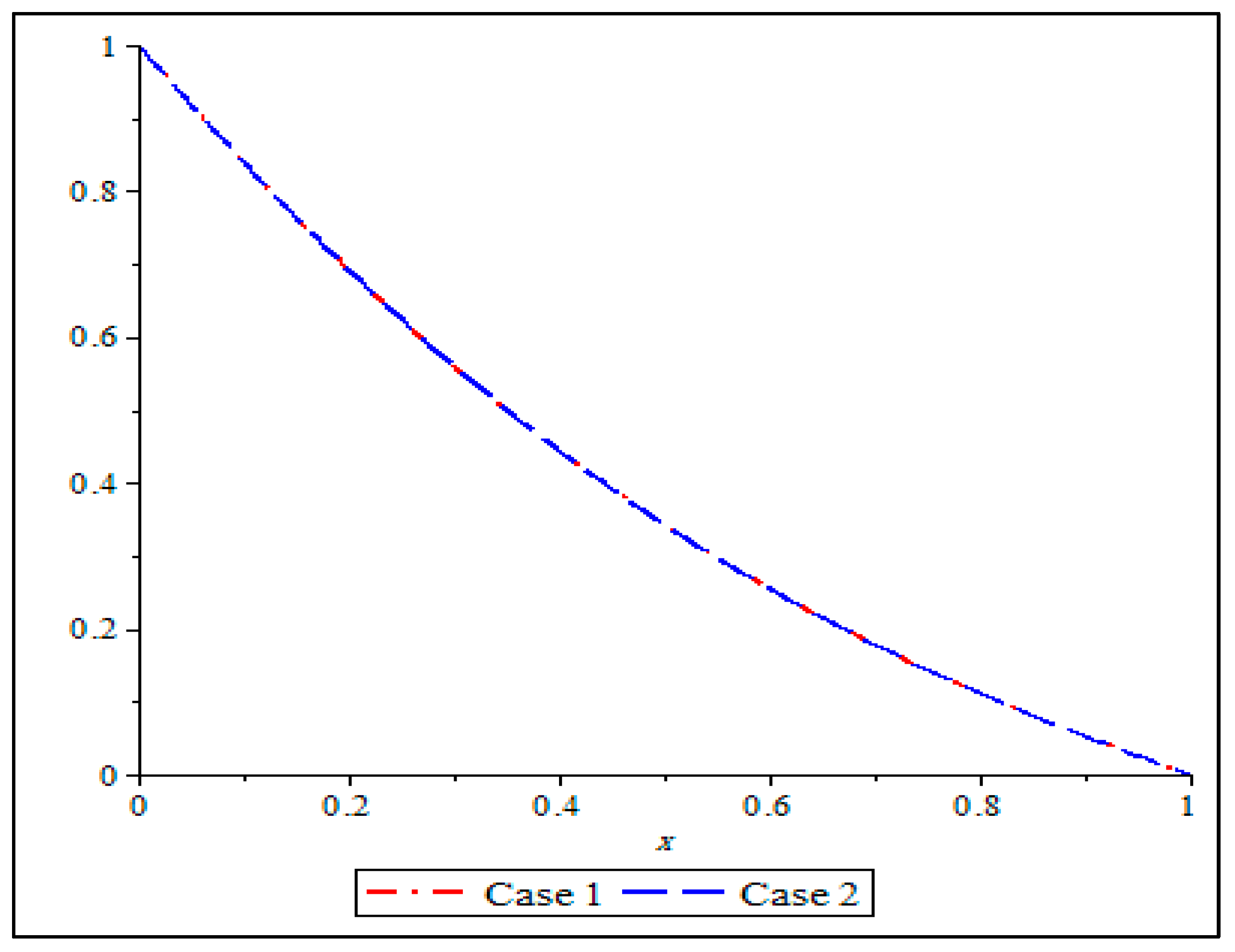1. Introduction
Systems of second-order ordinary differential equations arise in modeling several physical phenomena in many fields, including engineering applications, financial applications, biological sciences, and mathematical physics, to mention just a few [
1,
2,
3]. Nevertheless, most of the renowned computational algorithms for treating these equations, especially when nonlinear terms are present, with initial conditions, cannot be utilized when boundary conditions are considered; the so-called boundary-value problems (BVPs). Thus, different researchers delved into a search for optimal computational methods for this class of equations, considering the nature of prescribed conditions on the governing boundary, not initial conditions, and, on the other hand, the presence of nonlinearity, which poses additional threats to existing approaches. Indeed, the well-known finite difference method that has been proven to solve the class of second-order linear differential equations efficiently finds it hard to tackle the counterpart class of nonlinear equations effectively, let alone the class of coupled systems of nonlinear second-order differential equations with boundary conditions. In short, the literature on reliable computational methods for solving BVPs for coupled systems of nonlinear second-order differential equations is sparse, which thus prompts a great need for more effective methods for this class of equations, considering their frequent discovery while modeling various scenarios in the aforementioned fields. In this regard, we make mention of various considerations in [
4,
5,
6,
7,
8], which lay several theoretical results for the existence of valid solutions for the coupled system of second-order differential equations; one may equally read the work of Valanarasu and Ramanujam [
9], which devised an effective approach specifically of the class of coupled systems of second-order singular linear differential equations. In addition, an efficient numerical approach based on the Adomian Chebyshev decomposition method for two-point boundary value problems was deployed in [
10] to solve the class of BVPs for systems of linear and nonlinear second-order differential equations. Furthermore, Öztürk [
11] introduced numerical solutions of systems of differential equations using the operational matrix method with Chebyshev polynomials, while Biazar et al. [
12] deployed the famous Adomian decomposition method (ADM) on certain systems of differential equations. Additionally, some of the salient characteristics of ADM in effectively solving the class of coupled second-order systems of differential equations, in particular, were unraveled by Sekar and Nalini [
13] by solving dissimilar types of equations, including stiff systems, singular systems, and some sort of stable and unstable systems of equations. What is more, Sekar and Nalini [
13] further made use of the Runge–Kutta method (RKM) to reaffirm the exactness of the devised ADM for the considered class of equations, in addition to comparing the results with those of the exact solution; the high accuracy of ADM has thus been reported. In addition, ADM has remained an effective and powerful semi-analytical method, which equally doubles as a numerical, or rather computational method for solving wide classes of functional equations. The convergence of ADM has been considered in [
14,
15,
16,
17]. Cherruault [
14] gave the first proof of the convergence of the Adomian decomposition method using fixed-point theorems for abstract functional equations. A new formula that easily calculates Adomian’s polynomials used in the decomposition methods has been given in [
15]. Gabet in [
16] generalized the convergence results obtained by Cherruaulet in Banach space, while Babolian and Biazar [
17] used Cherruaulet’s definition and considered the order of convergence of the method.
However, based on the aforementioned importance for the class of BVPs, featuring nonlinear coupled systems differential equations, the scarcity of reliable computational methods for solving the latter class of equations, as well as the effectiveness of ADM in handling wide classes of functional equations, the current study thus aims to make use of one of the promising modifications of ADM, the double decomposition method (DDM) [
18] to computationally examine the class of nonlinear coupled systems of differential equations with the prescription of two-point boundary conditions. Moreover, DDM was initially introduced in 1993 by Adomian and Rach [
18] to primarily augment the rapidity of the classical ADM. Certainly, the modification method for ADM has been proven to solve various types of coupled differential equations, including nonlinear models with different boundary conditions, with faster convergence and higher accuracy. Moreover, several scientists deployed DDM to different mathematical models and positively reported the virtues of the method over many other approaches; see the works of Aminataei and Hosseini [
19] and AL-Zaid et al. [
20] that examined various BVPs for nonlinear ordinary differential equations. In this study, we extend the work in [
20] to apply DDM for solving BVPs of coupled systems of linear and nonlinear differential equations. Therefore, through the full utilization of DDM, the resultant computational recursive scheme of the governing BVP will be constructed and further simulated numerically for various test problems. In this regard, DDM will be deployed to assess the computational efficiency of the method. Moreover, the study is further set to report its findings in tables and graphical illustrations. Finally, the study is arranged as follows:
Section 2 outlines the steps for DDM;
Section 3 presents some numerical examples, while
Section 4 gives some concluding remarks.
2. Double Decomposition Method for Systems of Boundary Value Problems
Consider the general form of the nonlinear coupled system of higher-order nonhomogeneous ordinary differential equations as follows:
or simply, in an operator notation form as follows:
where
is a n-th order differential operator in the first equation and
is m-th order differential operator in the second equation, that is,
,
, while
and
are nonlinear functions and
are source terms.
Further, the inverse operators of
and
are defined as indefinite integration as follows:
Moreover, upon applying these inversion operators,
to both sides of the first equation and
to both sides of the second equation, one obtains:
where
and
are new functions, which arise from the application of
and
, respectively. In addition, the standard ADM procedure [
21] proceeds to decompose the unknown functions
and
into sums of infinite series of components as follows:
while the nonlinear terms
and
are equally decomposed into sums of infinite series of Adomian polynomials
and
respectively, as follows [
21,
22]:
Further, the deployed DDM [
18,
19,
20] equally suggests that new functions
and
in Equation (3), the expression should evenly be decomposed into the following sums of infinite series of components:
Thus, Equation (3), when expressed using the above decomposed components, yields:
Moreover, the inverse differential operators
and
in DDM, it is considered to be the nth and mth-fold indefinite integration, respectively; thus, one achieves
where
and
are constants to be determined from the prescribed boundary conditions.
Furthermore, the DDM reveals the resulting solution from Equation (4) as follows:
In addition, the approximate solution is thus obtained as follows:
the constants
and
can be explicitly obtained by equalizing each partial sum
and
to the boundary value conditions and solving the obtained systems of linear equations.
and
is determined completely by matching
and
to the boundary conditions and solving the obtained systems of linear equations. So, we now go to the next approximation
and
by first determining
to achieve
Matching and to the boundary conditions to evaluate the constants, and is determined completely. Continuing in this manner, we determine and until we arrive at a satisfactory and
3. Numerical Examples
The current section verifies the efficacy of the proposed DDM for the coupled systems of both the linear and nonlinear BVPs by portraying its applications on several test BVPs with boundary conditions, including a real physical model for the flow of blood in the human system. In addition, the section seeks to compare the proposed method with some existing computational methods in the literature. In addition, the section concludes by reporting the absolute error differences
, between the proposed method, and that of the exact and comparing solutions in
Table 1,
Table 2,
Table 3,
Table 4,
Table 5 and
Table 6, while
Figure 1,
Figure 2,
Figure 3 and
Figure 4 display the graphical illustrations of the development.
Example 1. Consider the coupled system of linear second-order nonhomogeneous BVP as follows [23,24]:where
and are given byand In addition, the following exact analytical solution is satisfied by the system:
Accordingly, applying the inverse operator
to both sides of the above system with DDM, we obtain the following recursive scheme:
where
and
. Then,
In addition, the unknown constants are consequently obtained from the imposed boundary conditions.
Hence, matching
and
to the boundary conditions, we obtain the following systems of linear equations:
and
From the solution of the above systems of linear equations, we obtain the constants
,
, and
as:
So,
and
are obtained as follows:
so that
and
is determined completely.
Next, we proceed to determine
and
as follows:
More so, on using the boundary conditions in the above relation and solving the obtained systems of linear equations, we obtain the constants as follows:
where the explicit expression of
and
follows as:
Continuing in the same manner, we obtain and , and so on.
Therefore, on comparing the first ten iterations
and
with the exact solution,
Table 1 gives the absolute error between the exact and DDM solutions for
and
when
, while
Figure 1 depicts the curves of
,
and the exact analytical solution expression in the approximate region
Table 1.
Absolute error between the exact and DDM solutions when in Example 1.
Table 1.
Absolute error between the exact and DDM solutions when in Example 1.
| | |
|---|
| 0.0 | | |
| 0.1 | | |
| 0.2 | | |
| 0.3 | | |
| 0.4 | | |
| 0.5 | | |
| 0.6 | | |
| 0.7 | | |
| 0.8 | | |
| 0.9 | | |
| 1.0 | | |
Figure 1.
Comparison between the exact and DDM solutions for and in Example 1.
Figure 1.
Comparison between the exact and DDM solutions for and in Example 1.
Table 2.
Comparison between different methods when in Example 1.
Table 2.
Comparison between different methods when in Example 1.
| Numerical Methods | LMQDQ [23] | B-Spline [24] | DDM |
|---|
| Maximum error for . | | | |
| Maximum error for | | | |
Notably,
Table 2 compares the effectiveness of the proposed DDM on the examination of coupled system with the help of the LMQDQ [
23] and B-spline [
24] methods when
. Certainly, the proposed method has been noted to be the most truthful computational method among the three contending approaches, looking at the minimal error portrayed by the presented approach and indeed its closeness to the exact analytical solution.
Example 2. Consider the coupled system of nonlinear second-order nonhomogeneous BVP as follows [25]:where
and
are given as follows:and In addition, the following exact analytical solution set is satisfied by the system:
Consequently, applying the inverse operator
to both sides of the above system with DDM, we obtain the following recursive scheme
where
and
are the Adomian polynomials for the nonlinear term
, which are to be recursively determined using the inventive Adomian algorithm [
21,
22] as:
Furthermore, the first iteration takes the following form:
Next, the related unknown constants,
and
in the latter iteration are obtained from the already declared boundary conditions as follows:
In addition, based on the acquired recursive formula for the system, one achieves the subsequent iteration, the expressions for
and
as follows:
Continuing to use the above process, we obtain , and so on.
In the same fashion, the sum of the first ten iterations, that is,
and
for the solution pair
and
is compared with the exact solution in
Table 3 for the computational results (absolute error difference) when
, and in
Figure 2 for the graphical depiction over the approximate region
Table 3.
Absolute error between the exact and DDM solutions when in Example 2.
Table 3.
Absolute error between the exact and DDM solutions when in Example 2.
| | |
|---|
| 0.0 | 0 | 0 |
| 0.1 | | |
| 0.2 | | |
| 0.3 | | |
| 0.4 | | |
| 0.5 | | |
| 0.6 | | |
| 0.7 | | |
| 0.8 | | |
| 0.9 | | |
| 1.0 | 0 | |
Figure 2.
Comparison between the exact and DDM solutions and in Example 2.
Figure 2.
Comparison between the exact and DDM solutions and in Example 2.
Table 4.
Comparison between HPM and DDM when in Example 2.
Table 4.
Comparison between HPM and DDM when in Example 2.
| Numerical Methods | HPM [25] | DDM |
|---|
| Maximum error for . | | |
| Maximum error for | | |
Remarkably, while trying to assess the efficacy of the proposed method, the study refers to the good work of Saadatmandi et al. [
25], where the notable homotopy perturbation method (HPM) was used to examine the governing coupled nonlinear system. Therefore,
Table 4 shows the error difference comparison between the proposed DDM and HPM [
25] when
, where one can easily note the truthfulness of the proposed approach over HPM, looking at the minimal error portrayed.
Example 3. Consider the coupled system of nonlinear BVP for the flow of magnetized blood in a blood vessel as follows [26]: In fact, such a fluid dynamical model, presided over by the above coupled “equations models a laminar magnetohydrodynamic flow of a non-Newtonian viscous fluid in a semi-porous channel under the influence of an axial uniform static magnetic field.
and
are the mean axial and normal velocity components, respectively,
is the Hartmann number, and
is the Reynolds number”; read [
26] for more details about the physics of the model.
Further, applying the inverse operator
to both sides of the first equation with DDM, we obtain the following recursive scheme:
while applying the inverse operator
to both sides of the second equation with DDM, we obtain the following recursive scheme
where
and
and
arising the derived recursive schemes represent the Adomian polynomials for the nonlinear terms
and
; their computation is equally performed using the Adomian prescription [
21,
22]. Accordingly, the first iteration takes the following form:
where the corresponding unknown constants are computationally found to be:
Next, the subsequent iteration,
and
are obtained as follows:
In the same fashion, we determine , and so on.
Moreover, the computational simulation of the acquired approximate numerical results, via DDM, is given here, governing the flow of magnetized blood in the blood vessels of the human system. More specifically, two cases for fixed
and
values are considered, and further sought the help of the Polynomial Least Squares Method (PLSM) [
26] for computational validation. Thus, in
Table 5 and
Table 6, we estimated the error in
using
, and in
using
; as the governing model has no known exact analytical solution, and is further validated with the PLSM [
26] solution. Additionally,
Figure 3 and
Figure 4 graphically portray this development. Eventually, in both solution pairs, the adopted DDM remarkably gave the most precise approximation, more especially, after looking at the error posed by the comparing PLSM [
26].
Table 5.
Comparison of the errors of the approximate solutions for and in Example 3.
Table 5.
Comparison of the errors of the approximate solutions for and in Example 3.
| Case 1
| Case 2
|
|---|
| | | |
|---|
| 0 | | 0 | | 0 |
| 0.1 | | | | |
| 0.2 | | | | |
| 0.3 | | | | |
| 0.4 | | | | |
| 0.5 | | | | |
| 0.6 | | | | |
| 0.7 | | | | |
| 0.8 | | | | |
| 0.9 | | | | |
| 1.0 | | | | |
Table 6.
Comparison between PLSM and DDM in Example 3.
Table 6.
Comparison between PLSM and DDM in Example 3.
| Numerical Methods | Case 1
| Case 2
|
|---|
| PLSM [26] | DDM | PLSM [26] | DDM |
|---|
| Maximum error for | | | | |
| Maximum error for | | | | |
Figure 3.
Comparison of approximate solutions of DDM for the two cases for in Example 3.
Figure 3.
Comparison of approximate solutions of DDM for the two cases for in Example 3.
Figure 4.
Comparison of approximate solutions of DDM for the two cases for in Example 3.
Figure 4.
Comparison of approximate solutions of DDM for the two cases for in Example 3.










